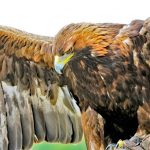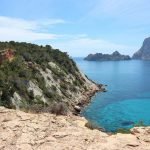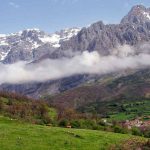La Axarquía and it’s birds
Most people I know who find themselves in La Axarquía, a region in the Andalucian province of Málaga, have been introduced to the area somehow or by someone, as it is really unlikely that you would just happen to be passing through.
Just 15 years ago you would have needed to be a really intrepid explorer or on the run, to decide to head up into the hills here, as once you left the coastline which stretches from just east of Málaga to the Granada border you would find yourself entering a patchwork labyrinth of hills and valleys that you could quite possibly never find your way out of again. Most villagers were forcibly sedentary, having very few cars and even fewer roads and a complicated network of hills and river valleys to negotiate to leave their village and head for the next. Due to their isolation each of the 30 plus white-washed villages in La Axarquía have a very strong individual identity with different gastronomy, land produce, music and wine and yet they are all within an area of just 1000km square.
Today, life in rural Axarquía is not dramatically different, however a growing ex-pat community and a few European grants are forcing it to move into at least the latter part of the 20th Century by concreting dirt tracks, damming a few rivers and putting up a few sign posts here and there.
La Axarquía is not unlike the more familiar Las Alpujarras region of the Sierra Navada in Granada but on a smaller scale and at a lower altitude. Totally in accessible “campo” houses, whose Spanish owners abandoned years ago for the convenience of the major towns of Velez Málaga, Torre del Mar & Nerja, are once again being inhabited by ex-pats who at first do not mind having to use a mule to scale the sheer hillside up to their house with the weekly shopping or to attach a snorkel pipe to their 4×4 to pass the river which crosses their track that was a delightful little stream when they moved in. However, over the years, one too many casualties, rising pressure from “cut off” Northern Europeans plus the increasing need for services such as telephones, electricity and more and more water has begun to bring an element of civilisation to the place.
The wildlife, however, is relatively safe from too much modernization as the shear-sided hills, and often impenetrable river valleys have forced farming methods to stay well and truly in the dark ages. Fields are often still ploughed by mules, with very small plots, lots of rotation year by year and a varied crop. Also much of the land that is bought by foreigners is often just left to naturalize itself eventually due to no farming activity at all. At first it sounds like a good idea to harvest your own olives and almonds, and send them back to your friends in England as Christmas presents, and then you realise that the local hill farmers really are half man and half goat, essential for skipping up and down the sheer cliffs with sacs of avocados, and decide to buy your olives from him instead and enjoy all the pretty flowers that appear on your land in the Spring.
Over the years I have become interested in all aspects of the flora and fauna in La Axarquía but I originally came here to explore the birdlife which is unbelievably plentiful once you do decide to step away from the coast.
In the spring almost every hill and river valley, of which there are hundreds, has Golden Orioles in the Eucalyptus, a Hoopoe on the track and a flock of Bee-eaters overhead. Flocks of Serins, Corn Buntings, Greenfinches, Goldfinches and Linnets constantly flit though the olive groves and a Blue Rock Thrush will be sat on top of the deserted ruin. As you drive or walk around the area Woodchat Shrike, Fan-tailed Warbler, Black Redstart, Spotted Flycatcher, Red-rumped Swallow, Wryneck and even Rufous Bush Robin are common, and Little and Scops Owl are frequently seen and heard respectively. Overhead you can see Black Kite, Bonelli’s, Booted and Short-toed Eagle, plus large flocks of Griffon Vultures and sometimes the odd Golden Eagle from the nearby sierras. All common Spanish species I know, but this is just in the garden!
My most romantic and favourite garden bird has to be the local Eagle Owl which hails the start of each evening as it wakes up with its haunting call and I often catch a shadowy glimpse as it sets our for the night. On one particularly sleepless night (for reasons I won’t bore you with) I was fascinated as the owl seemed to make its very final call of the night at the exact same second as daylight broke. On another sad note its partner was found victim to the progress of the area when it got tangled up on a nearby telephone wire and never returned one morning. The Eagle Owl and I needed to have a chat and a bottle of Chardonnay together I think!
La Axarquía is bordered in the east by the Montes de Malaga, a range of medium sized mountains covered in Scrub and Pine forest with a few Cork Oaks here and there. To the north, north-west & west are the Sierras Camarolos, Jobo, Alhama, Tajeda and Almijara, a range of larger “grey” mountains which rise to a peak of 2,065m at La Maroma and form a natural border with the Granada province. The Mediterranean Sea is the border to the south.
A trip to the eastern slopes of the Montes de Málaga within Axarquía, offers a lovely change of scene with all its dense, lush pine forest and regularly maintained tracks! Here I often see Bonelli´s, Spectacled, Subalpine, Melodious and Dartford Warbler, along with Crested Tits, Crossbills and Nuthatch. Greater Spotted & Green Woodpecker are here and I always hope to see a Goshawk (not often disappointed) plus a rare daytime view of a disturbed Tawny Owl which is a real treat. One Autumn evening driving back up from the city though the Montes de Málaga, I flushed up 25 Red-necked Nightjars along the road at a distance of about half a kilometre apart.
Venturing west to the higher sierra you can often feel like you are the only person left on the planet. No tourists here just the odd goat herder and a wealth of different birdlife. Rock Thrush, Black & Black-eared Wheatear, Cirl Bunting, Chough, Golden Eagle and even Quail where it flattens out over the Granada pass (just out of Axarquia though). This area is a massive contrast from the localised hills and valleys only 15km away as the crow flies. No Crows here though! This is the only place in La Axarquía that I have seen Azure-winged Magpie and I have never actually seen a Common Magpie here.
To the south is approximately 35km of, in places, totally undeveloped Mediterranean coastline where the usual sea faring birds can be seen plus the occasional sighting of Common Dolphins. Sea watching can be a bit of a let down though as things often seem to be a bit far out.
The major river is the Rio Velez which reaches the sea just east of the coastal town of Torre del Mar. Here you can see just about anything from a wide array of resident, migrant and wintering waders, herons & ducks to the odd stray Greater Flamingo, hoards of Little & Cattle Egrets but also unfortunately lots of men in the bushes! There is a naturist beach and the surrounding bamboo plantation is a bit of a dodgy area. I do not recommend a visit on your own if you are a woman, however, the men are not really interested in women so maybe its best not to visit alone if you are a man?! Oh I don´t know. I just feel a little uncomfortable here. No offence intended though.
As I mentioned before all of this is within a considerably small area of only 1000km square and at any time of year a good species list can be obtained, apart from in July & August when everything seems to go to ground. Also apart for the birds the rich Moorish history is constantly in evidence and largely left untouched and a wide variety of other wildlife exists alongside the birds.
Also if you do get lost you can always find a friendly Spaniard or ex-pat who will help you as I once needed when my children and I took a wrong turning at the top of a mountain and ended up driving down an eroded goat track in a Ford Focus hire car and appeared up in a kindly Australian man’s back garden! Not recommended but his home brew was good!







